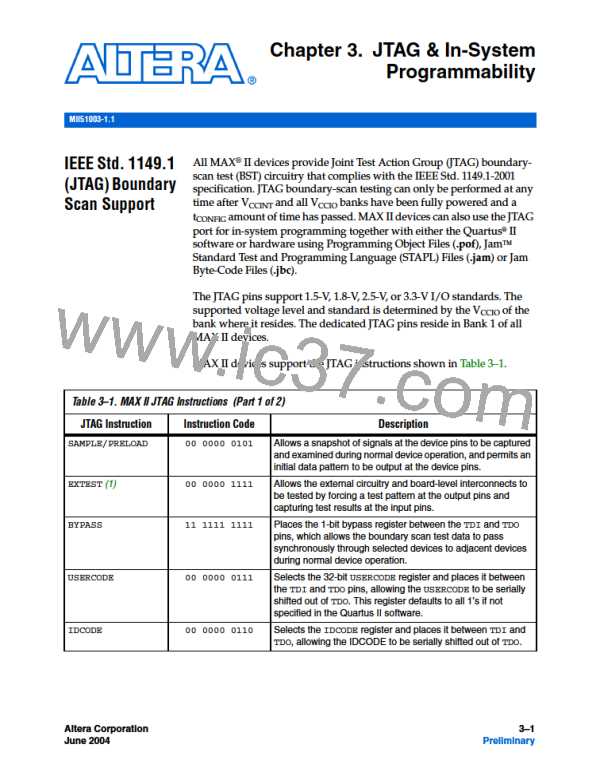JTAG & In-System Programmability
Programming Sequence
During in-system programming, 1532 instructions, addresses, and data
are shifted into the MAX II device through the TDIinput pin. Data is
shifted out through the TDOoutput pin and compared against the
expected data. Programming a pattern into the device requires the
following six ISP steps. A stand-alone verification of a programmed
pattern involves only stages 1, 2, 5, and 6. These steps are automatically
®
executed by third-party programmers, the Quartus II software, or the
Jam STAPL and Jam Byte-Code Players.
1. Enter ISP – The enter ISP stage ensures that the I/O pins transition
smoothly from user mode to ISP mode.
2. Check ID – Before any program or verify process, the silicon ID is
checked. The time required to read this silicon ID is relatively small
compared to the overall programming time.
3. Bulk Erase – Erasing the device in-system involves shifting in the
instruction to erase the device and applying an erase pulse(s). The
erase pulse is automatically generated internally by waiting in the
run/test/idle state for the specified erase pulse time of 350 ms.
4. Program – Programming the device in-system involves shifting in
the address, data, and program instruction and generating the
program pulse to program the flash cells. The program pulse is
automatically generated internally by waiting in the run/test/idle
state for the specified program pulse time of 75 µs. This process is
repeated for each address in the CFM block.
5. Verify – Verifying a MAX II device in-system involves shifting in
addresses, applying the verify instruction to generate the read
pulse, and shifting out the data for comparison. This process is
repeated for each CFM address.
6. Exit ISP – An exit ISP stage ensures that the I/O pins transition
smoothly from ISP mode to user mode.
For TCKfrequencies of 10 MHz, the erase and programming takes less
than one second for EPM240 and EPM570 devices. Erase and
programming times are less than two seconds for EPM1270 and less than
three seconds for the EPM2210 devices. The TCKfrequency can operate at
up to 25 MHz in MAX II devices providing slight improvements in these
ISP times.
Altera Corporation
June 2004
Core Version a.b.c variable
3–7
MAX II Device Handbook, Volume 1

 ALTERA [ ALTERA CORPORATION ]
ALTERA [ ALTERA CORPORATION ]